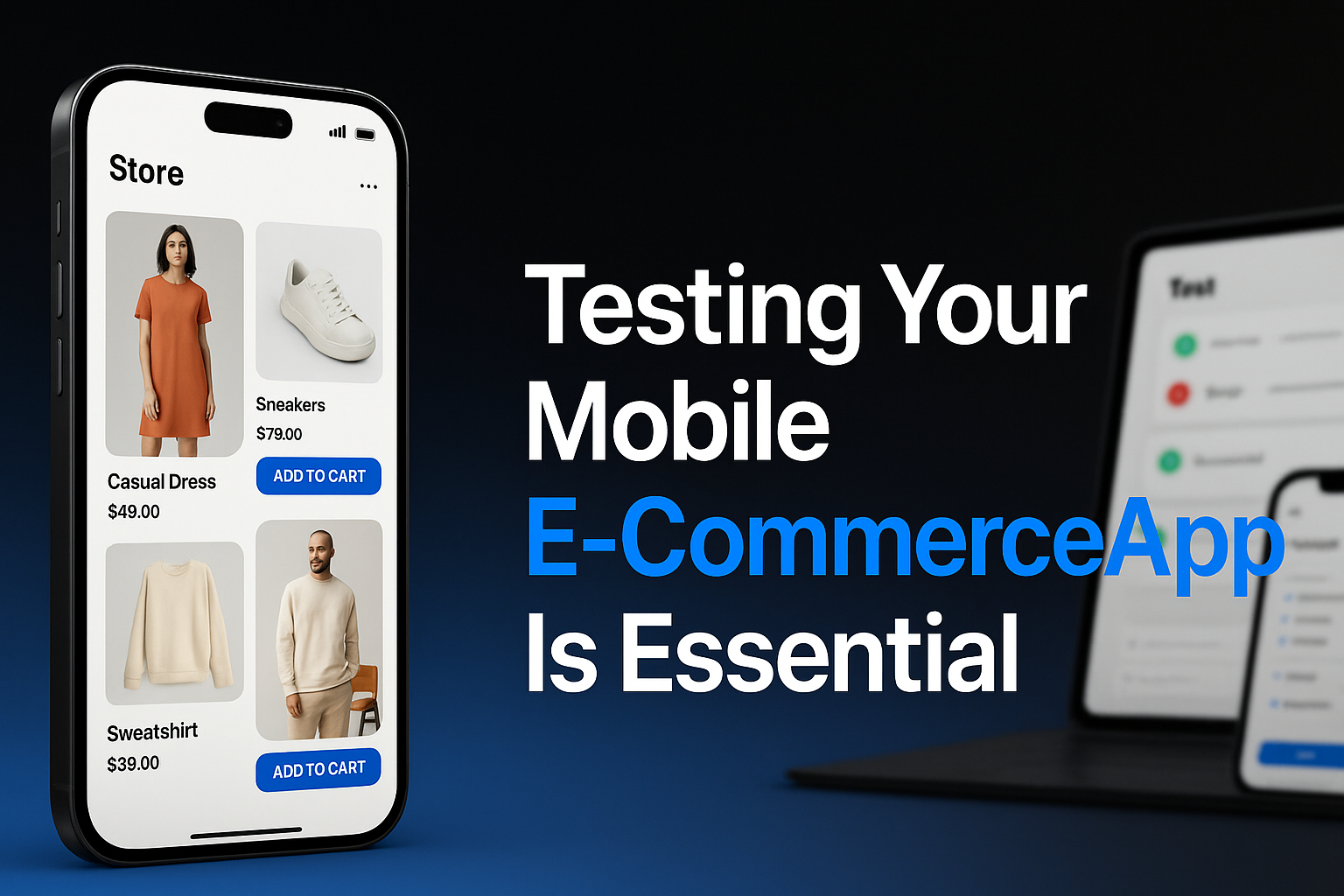Why Testing Your Mobile E-Commerce App Is Non-Negotiable
Mobile commerce now drives most of e-commerce traffic. Releasing app updates without proper testing can seriously damage your business. Even small technical issues can lead to major financial losses.
Before diving into testing, make sure you have a solid strategy for your mobile app. Check out our guide on industry-specific e-commerce strategies to ensure your app meets your business needs.

The Real Cost of Skipping App Testing
Consider these sobering realities:
- The vast majority of users won't return to a site after a bad experience
- Most mobile users quickly abandon sites that take too long to load
- A single crash can cause many users to uninstall your app permanently
- E-commerce conversion rates drop significantly with each second of delay
A simple example shows the impact: If your online store makes $10,000 daily and a bug breaks your checkout process for just one day, you could lose all that revenue instantly. And that doesn't even account for long-term damage to customer trust.
Seven Critical Risks of Inadequate Mobile App Testing
1. Revenue Loss Through Abandoned Transactions
Payment processing issues, checkout bugs, or form validation errors directly translate to lost sales. These functional problems can occur when:
- New features interact unexpectedly with existing code
- API endpoints change or experience timeouts
- Payment gateways update their requirements
Without thorough testing, these issues often remain undetected until customers start abandoning their carts in frustration.
2. Damaged Brand Reputation
In today's connected world, negative app experiences spread quickly:
- App store ratings and reviews provide immediate, public feedback
- Social media amplifies customer complaints exponentially
- Review sites catalog and preserve negative experiences indefinitely
Once established, a reputation for buggy software is extraordinarily difficult to overcome.
3. Decreased Customer Retention and Lifetime Value
Acquiring new customers costs 5-25 times more than retaining existing ones. App issues that drive customers away have a compound negative effect:
- Immediate loss of the current transaction
- Loss of all future purchases from that customer
- Increased marketing costs to replace lost customers
4. Competitive Disadvantage
When competitors offer seamless mobile experiences while your app suffers from issues, customers naturally gravitate toward more reliable options:
- Many customers would rather switch than deal with outdated or buggy apps
- A substantial number of users have switched to a competitor after a poor mobile experience
5. Reduced Marketing ROI
Bugs and performance issues undermine your marketing investments:
- Ads driving traffic to non-functioning features waste ad spend
- Promotion codes that fail due to implementation errors damage campaign effectiveness
- Push notifications linking to slow-loading pages reduce engagement rates
6. Support Cost Escalation
Untested releases typically result in:
- Increased customer service inquiries
- Higher ticket resolution times
- Need for emergency developer interventions
- Rushed hotfixes that may introduce additional problems
7. App Store Rejection or Removal
Both Apple and Google have increasingly stringent quality requirements:
- Apps with frequent crashes face removal from stores
- Security vulnerabilities can result in immediate takedowns
- Poor performance metrics trigger warnings and eventual delisting
What Needs Testing in E-commerce Apps?
Effective testing strategies for mobile commerce must cover:
Functional Testing
- Account creation and login processes
- Search functionality
- Product filtering and sorting
- Cart and checkout flows
- Payment processing
- Order tracking
- User profile management
Performance Testing
- Load times for product pages
- Image loading and optimization
- Response times under various network conditions
- App behavior during peak traffic periods
- Memory usage and battery consumption
Compatibility Testing
- Performance across different device models
- Adaptation to various screen sizes
- Functionality with different OS versions
- Behavior with various permission settings
Security Testing
- Data encryption during transmission
- Secure storage of user information
- Protection against common vulnerabilities
- Compliance with relevant regulations (GDPR, CCPA, etc.)
User Experience Testing
- Intuitiveness of navigation
- Clarity of error messages
- Accessibility features
- Consistency of design elements
When to Test Your Mobile App
While continuous testing is ideal, certain scenarios absolutely require comprehensive testing:
- Before major feature releases
- After integrating with new third-party services
- Following significant UI/UX redesigns
- When updating critical paths like checkout or registration
- Before backend system changes
- Before promotional campaigns that will increase traffic
- When expanding to new markets or demographics
Speaking of promotional campaigns, don't miss our article on effective mobile app promotion strategies to maximize your app's visibility after ensuring it's perfectly tested.
Implementing Effective Testing for Your Mobile E-commerce App
The good news? Implementing effective testing doesn't have to be complicated or time-consuming with the right tools and approach.
Real-Time Preview Testing with Taptool Designer
For quick iterative changes and immediate feedback, Taptool offers a streamlined preview system:
- Make changes to your app in the Taptool platform
- Generate a QR code preview link
- Scan the code with the Taptool Designer app on your device
- Interact with your app in real-time
- Make adjustments and repeat
This approach allows you to catch obvious issues before they ever reach your customers. Learn more about using Taptool Designer in our detailed guide.
Beta Testing with TestFlight
For more comprehensive testing before public release, TestFlight provides a structured approach:
- Distribute pre-release versions to internal team members and trusted customers
- Collect real-world usage data and feedback
- Identify edge cases and unexpected user behaviors
- Validate fixes before App Store submission
Our comprehensive guide explains the complete TestFlight testing process with Taptool.
Test-Driven Success Stories
Companies that prioritize testing consistently outperform their competitors:
-
Electronics Direct discovered a critical payment processing bug during TestFlight beta testing that would have affected a substantial portion of transactions during their Black Friday promotion.
-
Home Essentials used Taptool Designer to test their app's performance across different device types, identifying and fixing UI inconsistencies that notably improved their app store rating.
Building a Culture of Quality
Beyond tools and processes, successful mobile commerce businesses foster a culture that values quality:
- Make testing a requirement, not an option: Build testing time into project timelines
- Involve multiple perspectives: Include marketing, customer service, and sales in testing
- Learn from issues: Document bugs and their solutions to prevent recurrence
- Monitor continuously: Use analytics to identify potential issues even after release
- Test competitors regularly: Understand how your app compares to alternatives
Conclusion: Testing as Investment, Not Expense
While thorough testing requires an investment of time and resources, it should be viewed as insurance against much costlier problems. The return on investment becomes clear when considering:
- Preserved revenue from uninterrupted sales
- Strengthened customer loyalty and lifetime value
- Reduced emergency support and development costs
- Protection of brand reputation and competitive position
In today's competitive mobile commerce landscape, comprehensive testing isn't just a best practice — it's a business necessity that directly impacts your bottom line.
Ready to implement professional testing for your mobile e-commerce app? Explore Taptool Designer for real-time testing and TestFlight integration to ensure your app delivers a flawless experience to every customer.
